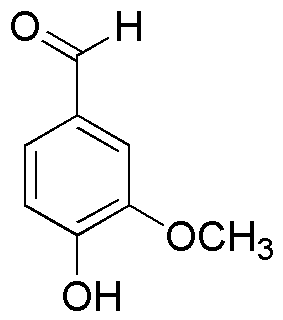Vanillin is widely utilized in research focused on:
- Food Industry: As a natural flavoring agent, vanillin enhances the taste of various food products, including baked goods, chocolates, and beverages, making them more appealing to consumers.
- Fragrance Development: In perfumery, vanillin is a key ingredient that adds a sweet, creamy scent to perfumes and scented products, improving their marketability.
- Pharmaceuticals: It serves as a flavoring agent in medicinal syrups and formulations, improving patient compliance, especially in pediatric medicine.
- Cosmetics: Vanillin is used in cosmetic products for its pleasant aroma and antioxidant properties, enhancing product appeal and effectiveness.
- Research Applications: In laboratories, vanillin is utilized as a reagent in organic synthesis and analytical chemistry, aiding in the development of new compounds and materials.
General Information
Properties
Safety and Regulations
Applications
Vanillin is widely utilized in research focused on:
- Food Industry: As a natural flavoring agent, vanillin enhances the taste of various food products, including baked goods, chocolates, and beverages, making them more appealing to consumers.
- Fragrance Development: In perfumery, vanillin is a key ingredient that adds a sweet, creamy scent to perfumes and scented products, improving their marketability.
- Pharmaceuticals: It serves as a flavoring agent in medicinal syrups and formulations, improving patient compliance, especially in pediatric medicine.
- Cosmetics: Vanillin is used in cosmetic products for its pleasant aroma and antioxidant properties, enhancing product appeal and effectiveness.
- Research Applications: In laboratories, vanillin is utilized as a reagent in organic synthesis and analytical chemistry, aiding in the development of new compounds and materials.
Documents
Safety Data Sheets (SDS)
The SDS provides comprehensive safety information on handling, storage, and disposal of the product.
Product Specification (PS)
The PS provides a comprehensive breakdown of the product’s properties, including chemical composition, physical state, purity, and storage requirements. It also details acceptable quality ranges and the product's intended applications.
Certificates of Analysis (COA)
Search for Certificates of Analysis (COA) by entering the products Lot Number. Lot and Batch Numbers can be found on a product’s label following the words ‘Lot’ or ‘Batch’.
*Catalog Number
*Lot Number
Certificates Of Origin (COO)
This COO confirms the country where the product was manufactured, and also details the materials and components used in it and whether it is derived from natural, synthetic, or other specific sources. This certificate may be required for customs, trade, and regulatory compliance.
*Catalog Number
*Lot Number
Safety Data Sheets (SDS)
The SDS provides comprehensive safety information on handling, storage, and disposal of the product.
DownloadProduct Specification (PS)
The PS provides a comprehensive breakdown of the product’s properties, including chemical composition, physical state, purity, and storage requirements. It also details acceptable quality ranges and the product's intended applications.
DownloadCertificates of Analysis (COA)
Search for Certificates of Analysis (COA) by entering the products Lot Number. Lot and Batch Numbers can be found on a product’s label following the words ‘Lot’ or ‘Batch’.
*Catalog Number
*Lot Number
Certificates Of Origin (COO)
This COO confirms the country where the product was manufactured, and also details the materials and components used in it and whether it is derived from natural, synthetic, or other specific sources. This certificate may be required for customs, trade, and regulatory compliance.


